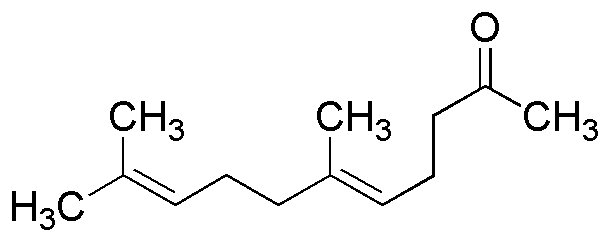6,10-Dimethyl-5,9-undecadien-2-one is widely utilized in research focused on:
- Flavor and Fragrance Industry: This compound is used as a flavoring agent in food products and as a fragrance component in perfumes, providing a sweet, fruity aroma that enhances sensory appeal.
- Aromatherapy: Its pleasant scent makes it popular in aromatherapy products, where it can promote relaxation and improve mood, offering a natural alternative to synthetic fragrances.
- Cosmetic Formulations: The compound is incorporated into skincare and cosmetic products for its aromatic properties, enhancing the overall user experience while providing a natural scent.
- Pesticide Development: Research indicates its potential use in developing natural insect repellents, providing an eco-friendly alternative to synthetic pesticides, which can be harmful to the environment.
- Biological Research: It serves as a valuable tool in biological studies, particularly in understanding plant interactions and the role of volatile compounds in ecology.
General Information
Properties
Safety and Regulations
Applications
6,10-Dimethyl-5,9-undecadien-2-one is widely utilized in research focused on:
- Flavor and Fragrance Industry: This compound is used as a flavoring agent in food products and as a fragrance component in perfumes, providing a sweet, fruity aroma that enhances sensory appeal.
- Aromatherapy: Its pleasant scent makes it popular in aromatherapy products, where it can promote relaxation and improve mood, offering a natural alternative to synthetic fragrances.
- Cosmetic Formulations: The compound is incorporated into skincare and cosmetic products for its aromatic properties, enhancing the overall user experience while providing a natural scent.
- Pesticide Development: Research indicates its potential use in developing natural insect repellents, providing an eco-friendly alternative to synthetic pesticides, which can be harmful to the environment.
- Biological Research: It serves as a valuable tool in biological studies, particularly in understanding plant interactions and the role of volatile compounds in ecology.
Documents
Safety Data Sheets (SDS)
The SDS provides comprehensive safety information on handling, storage, and disposal of the product.
Product Specification (PS)
The PS provides a comprehensive breakdown of the product’s properties, including chemical composition, physical state, purity, and storage requirements. It also details acceptable quality ranges and the product's intended applications.
Certificates of Analysis (COA)
Search for Certificates of Analysis (COA) by entering the products Lot Number. Lot and Batch Numbers can be found on a product’s label following the words ‘Lot’ or ‘Batch’.
*Catalog Number
*Lot Number
Certificates Of Origin (COO)
This COO confirms the country where the product was manufactured, and also details the materials and components used in it and whether it is derived from natural, synthetic, or other specific sources. This certificate may be required for customs, trade, and regulatory compliance.
*Catalog Number
*Lot Number
Safety Data Sheets (SDS)
The SDS provides comprehensive safety information on handling, storage, and disposal of the product.
DownloadProduct Specification (PS)
The PS provides a comprehensive breakdown of the product’s properties, including chemical composition, physical state, purity, and storage requirements. It also details acceptable quality ranges and the product's intended applications.
DownloadCertificates of Analysis (COA)
Search for Certificates of Analysis (COA) by entering the products Lot Number. Lot and Batch Numbers can be found on a product’s label following the words ‘Lot’ or ‘Batch’.
*Catalog Number
*Lot Number
Certificates Of Origin (COO)
This COO confirms the country where the product was manufactured, and also details the materials and components used in it and whether it is derived from natural, synthetic, or other specific sources. This certificate may be required for customs, trade, and regulatory compliance.

